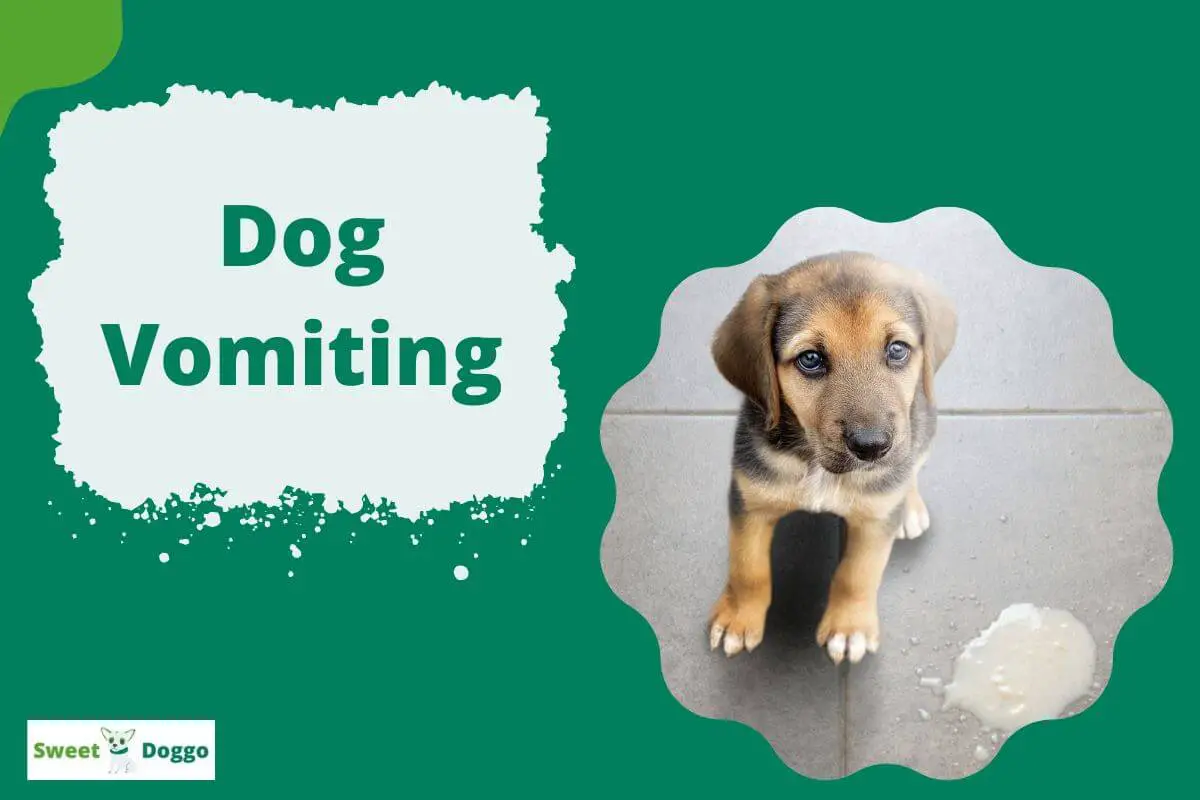Vomiting in dogs is a more common symptom than it seems. A dog may vomit because he has eaten too much or simply because he has swallowed the food too quickly. However, vomiting can also be a warning sign that something more serious is happening, such as the ingestion of a toxic substance or the presence of a condition that should be evaluated by the veterinarian.
In this article, you will find a summary of everything you need to know about dog vomiting: the main causes, types, and different colors of vomiting in dogs, and when a medical emergency should be considered. What other symptoms are usually present, what to do if your dog is vomiting and what you can give him, among other recommendations to take into account?
Note: During the writing of this article, different official sources specialized in veterinary medicine were consulted.
Table of Contents
How to know if a dog is really vomiting?
Although it may seem very obvious, it really is not. Sometimes it’s hard to tell if your dog is vomiting, or if it’s something else. As an owner, there is something you must learn to differentiate: between when the pet is vomiting and when he is regurgitating.
Vomiting and regurgitation are not the same things. The former is defined as the forced expulsion of the contents of the stomach and upper intestine. It may contain yellow bile or partially digested food and usually has a sour odor. Vomiting can occur several hours after eating and is always an active process involving some abdominal strain.
Instead, regurgitation is a mild, passive expulsion of undigested food from the esophagus through the mouth. It does not involve abdominal contractions and usually occurs shortly after eating.
Another detail that can help you tell the difference is that vomiting in dogs is almost always preceded by signs of nausea, such as drooling, lip licking, and excessive swallowing. Some dogs may also eat grass, probably in an attempt to protect the esophagus from damage from sharp objects or bone fragments.
Why does a dog vomit? Causes of acute vomiting and chronic vomiting
Depending on the case, vomiting can be classified as an acute symptom or a chronic problem. As raised by different sources, the common causes of acute vomiting in dogs are:
- The ingestion of irritating substances (garbage, chocolate, etc.)
- Ingestion of toxins or poison
- Changes in diet
- Food intolerances
- The ingestion of foreign bodies (toys, bones, pieces of chewing gum, etc.)
- Intestinal parasites
- A viral or bacterial infection
- A reaction to a medication
- Pancreatitis
- Kidney or liver failure
- Gallbladder inflammation
- Gas or bloating
- A heat stroke
Collaboration on the part of the owner is always essential to help the veterinarian in diagnosing the cause. For example, if your dog vomits after being outside in the sun or cooped up in a hot car, heatstroke may be the prime suspect.
If your dumpster shows evidence of a canine examination, then the vomiting is more likely due to the ingestion of garbage, a foreign body, or toxins. Likewise, you can report if the pet has had access to human medications, if it has been eating new foods, etc.
Acute vomiting in dogs, defined as sudden or severe episodes of vomiting, is a symptom linked to different disorders, diseases, and complications.
Now, there are cases where vomiting becomes a chronic problem. Frequent or prolonged vomiting is also a cause for concern, especially if it is accompanied by:
- Blood trails
- Abdominal pain
- Depression
- Dehydration
- Soft spot
- Fever
- Poor appetite
- Weight-loss
- Other unusual symptoms
Among the most common causes of chronic vomiting in dogs are:
- Bowel obstruction
- Cancer
- Parvovirus
- Colitis
- The constipation
- Liver disease
- Kidney or liver failure
- A systemic disease
- Bowel inflammation
- Pancreatitis
- A uterine infection
Most of these conditions are treatable, especially if they are addressed early. It should be noted that the type of vomiting caused by these conditions will not go away on its own; Veterinary intervention is necessary.
Types of Vomiting: What do the Colors of Vomit Mean in Dogs?
Although color is not always an exact and reliable characteristic, there is no doubt that it is sometimes an important factor in diagnosing the cause in less time.
Keep in mind that the appearance of the vomit can be influenced by foods of a certain color or anything else the dog has recently ingested. In that case, the color may not be significant.
However, when it is not possible to associate it with something the pet has eaten, then the color is probably relevant.
Let’s look at a summary of what some of the most common colors of dog vomiting can mean…
White vomit
If your dog has vomited white material, the first thing to do is determine if he is actually vomiting. Sometimes this can be the result of expectoration, which causes the pet to expel material from the throat or airways.
On the other hand, a regurgitant dog can also expel a certain amount of saliva that is accumulated in the esophagus.
Now, in case of confirming that it is vomiting, the white color usually indicates that the dog:
- You have an upset stomach. Many dogs with gastroenteritis experience white vomit when the stomach is empty.
- Has eaten grass or a small amount of other foreign material. If the dog has not eaten recently, the vomit may appear as white material with little or no substance.
- Although it is not common, it is known that when a dog expels white foam from the mouth, especially if we see that he is trying to vomit but cannot, it could be gastric dilatation-volvulus6, a life-threatening condition that requires emergency medical attention.
Read all about this topic in White Vomit in Dogs – Why is My Dog Vomiting White Foam?
Black vomit
Black vomit in dogs is not very common. It is usually a benign symptom and is related to digging in the dirt or eating dirt. However, in certain cases, it can indicate a serious health problem if it is due to the presence of digested blood.
Although digested blood almost always takes on a very dark brown or red hue, it can sometimes appear almost black. Among the most common causes are stomach ulcers or undigested toxins. If your dog is vomiting black material, and he doesn’t seem to be feeling well, get him checked out by a vet.
Red vomit
Red vomiting in dogs is always an alarming sign for owners. Unless your dog has eaten something red, this vomiting is usually a sign of fresh blood. It is important to note that even a small amount of blood can make it appear as if there is a lot of blood in the vomit, when in fact there is not as much.
The presence of blood in the vomit of dogs can be due to:
- Any irritation to the lining of the stomach or esophagus, possibly due to ingestion of a foreign body. This is a common cause of short-term vomiting of blood, a condition known as hematemesis.
- Gastritis. Inflammation in the stomach lining can also result in red vomit with blood in it. If it occurs only once, or the amount of blood is very small, this vomiting may not be a cause for alarm.
- When the vomit looks dark reddish, this indicates that the blood is partially digested, and therefore has been in the stomach for some time. Here the most common cause is a stomach ulcer.
Note. See your vet right away if your dog vomits dark reddish or black, similar in texture to coffee grounds, or if he vomits bright red blood.
Green vomit
Green vomit in dogs can be due to two main causes, neither of which necessarily indicates a serious problem. These are:
- The ingestion of plant material. It is quite common for dogs to ingest plant material, especially grass, when outside. It’s not known for sure if eating grass causes vomiting, but when the grass is present, chlorophyll often stains the liquid parts of the vomit in different shades of green, including saliva, bile, digestive enzymes, and stomach acid. Some dogs seem to vomit more easily after eating grass than others.
- The presence of bile. Similar to humans, green vomit in dogs can be due to the presence of bile.
- After the dog eats, the gallbladder releases bile into the upper part of the small intestine to aid in the absorption of fats and other nutrients. It is known that some of this bile can flow back into the stomach.
- From here there are two options: the simple fact that there is bile in the stomach can cause vomiting ( bilious vomiting syndrome ), or the dog is vomiting for another reason and the bile has stained the vomit green. Generally, if a dog vomits vibrant green it is because fresh bile has been expelled; that could indicate a lack of movement or blockage in the intestines, which often requires medical intervention.
More details in: Why is My Dog Vomiting Green? 4 Common Causes
Yellow vomit
Yellow vomit is usually a harmless sign. It generally occurs when the dog has an empty stomach and is associated with the presence of bile, although in lower concentration than in cases of green vomit. Maybe you just need to feed your dog more often, without exceeding the amount of food you’re used to giving him in a day.
Now, if your dog is vomiting yellow liquid and also seems lethargic or does not want to eat, it is best to go to the vet. This could be the symptom of a more serious health condition or problem.
More information at: Why is My Dog Vomiting Yellow? – What Causes It and How to Manage It?
Brown vomit
Dark brown vomit that has a very strong, unpleasant odor may be due to ingesting something inappropriate, including its own feces or the feces of another dog (coprophagia). But it could also indicate a blockage in the intestines, or that ingested material is refluxing from the intestinal tract into the stomach.
Also, some cases of dark brown vomit are caused by some type of internal bleeding or poisoning. If you notice that your dog vomits brown and seems to be sick, it is advisable to go to the veterinarian’s office.
Read more at Brown Vomit in Dogs – Why is My Dog, Vomiting Brown?
It is not always easy to identify the trigger or the content of the vomit, regardless of its color. It is important to pay attention to other signs, such as how often vomiting occurs if there is diarrhea, lack of appetite, or other unusual symptoms that cause concern.
What to do if my dog is vomiting? 4 helpful tips
- Tour and inspect the house. Did you notice that any part or toy is missing? Is there chewed-up litter or a sock missing? If so, it’s safest to take your dog to the vet for an urgent X-ray. If the foreign body is still in the stomach, vomiting can be induced to come out right away, which is better than surgery.
- Check the color of your dog’s gums. Make sure his gums don’t look too pale. If this is the case, or if the dog’s clinical signs are getting progressively worse, go to the vet.
Prevent the dog from drinking water for 6-12 hours. It is not recommended to give them water immediately after vomiting. - Prevent all access to food for 24 hours, unless your dog has a health condition that prohibits it (diabetes mellitus, history of hypoglycemia, etc.).
Recommended: How to Induce Vomiting in Dogs? Safe and Quick Remedy
Dog vomiting when to worry?
Seek emergency veterinary care if your dog exhibits any of the following signs:
- Multiple attempts to vomit, without actually expelling anything ( one of the most common signs of the life-threatening condition is gastric dilatation and volvulus )
- Vomiting and distended or painful abdomen
- Vomiting without wanting to get up
vomiting and collapse - Vomiting accompanied by pale, bluish, or gray gums
- Vomiting and fast heartbeat, shaking, or shortness of breath
- More than 6 vomiting in a day
Also go to the vet if:
- You suspect that your dog has swallowed a foreign body (toy, sock)
- Are you worried that he ate something poisonous?
- The dog wakes you up at night vomiting, acting anxious, and unable to calm down
- Your dog exhibits abnormal behavior
What is the diagnosis and what would be the medical treatment?
Determining the cause of vomiting in a dog almost always requires several steps. The vet will often ask about the dog’s possible access to litter, poisons, and toxins, as well as any recent changes in diet or if the pet has been exhibiting any other symptoms.
A physical exam will then be done and if the vet deems it necessary, he will also do some additional tests such as blood tests, ultrasound, x-rays, endoscopic evaluations, biopsy, and urinalysis.
Once the trigger for the vomiting is determined, your vet will devise a treatment plan based on the cause and your dog’s condition. Keep in mind that vomiting itself can create other problems, so in many cases treatment also includes measures for dehydration, electrolyte imbalances, and anti-nausea medications.




